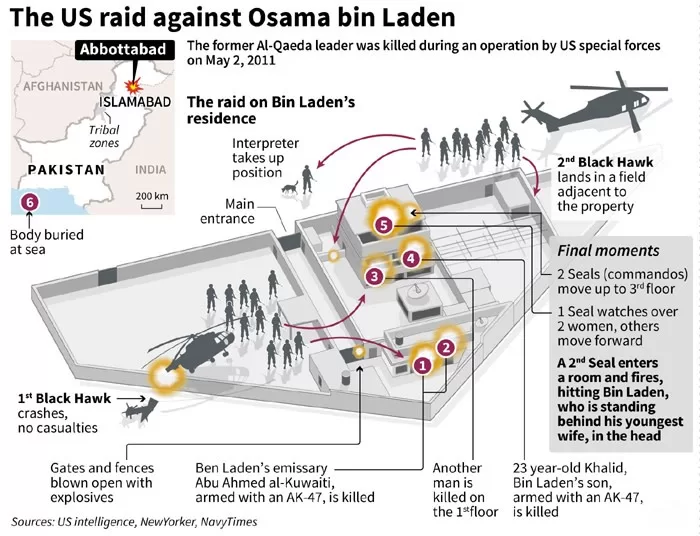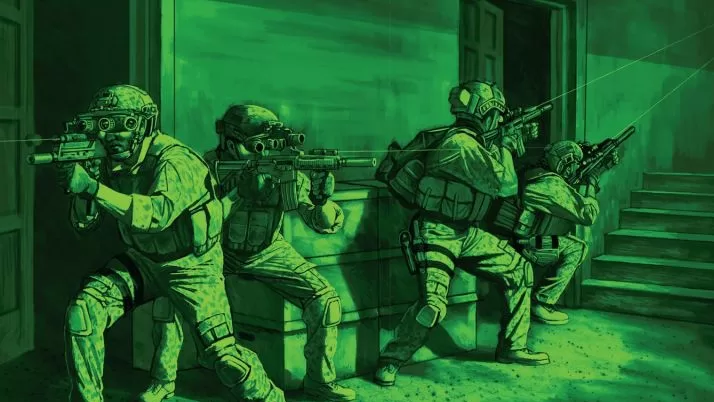The computerized log register at the Air House shows that an urgent telephone call for the Air Chief was received at 2:07 AM local time on 2nd May 2011. When the Air Chief came on line his land counterpart, the Army Chief was at the other end who informed him about confirmed reports of aerial activity, firing and a helicopter crash around Abbottabad. “Is there any flying activity from the PAF”, he inquired. The Air Chief replied in the negative. The only reason PAF helicopters would be flying at that late hours of the night would be if they were on a search and rescue mission in case a PAF aircraft was reported to have crashed in the area during night flying. He would have been informed about a downed aircraft. The Army Chief further elaborated that besides the suspicion that the air intrusion may have originated from the western border on a mission that was not yet clear and appeared to be the handiwork of the Americans, no other details was available at that point in time.
Unsettled by this alarming news he wondered what could be the objective of such a brazen raid. As far as his knowledge went, Abbottabad had nothing of strategic value to defend, else PAF would have deployed point-defence radar and other air defence systems to protect it against air or land attacks. Unless the Indians actually believed their oft repeated mantra about Kashmiri terror training camps at Mansehra, adjacent to Abbottabad and had undertaken a foolhardy adventure. Or perhaps the Americans under the misperception that some of Pakistan’s strategic assets were located in Abbottabad had conducted an airborne assault to seize them. That again made little sense because if USA does mount an operation to takeover/destroy Pakistan’s nuclear weapons, it would conduct a mass multiple raid rather than a solitary one. Whatever might be the motive of the aggressor, an immediate response from the PAF was warranted.
While still speculating about the motive and the nature of the apparent aerial attack, the Air Chief around 2:10 AM had issued orders to his Air Defence Commander to scramble a pair of F-16 fighters from the nearest base with instructions to go over Abbottabad, look for any flying intruders. If any were detected, they were clearly told to engage and shoot them down regardless of which country of origin they might belong to. This was really a very bold and courageous decision as by then it was becoming increasingly likely that USA rather than India was the aggressor. To protect the nation’s honour and dignity, PAF was prepared and ready to challenge and engage a far superior adversary boasting an annual budget of around US $ 171 billion in comparison to the meagre PAF’s annual budget of just about US $ 1.01 billion.
In addition he instructed immediate enhancement of air defence status of the entire country and directed the concerned staff to check and report to him about the status of all air defence radars and whether any of them picked up intruders from either side of the border or any jamming was experienced by the units, besides keeping him updated about the progress of the scrambled jets.
As the hours past, news started to trickle in that confirmed an aerial intrusion from the West ostensibly by US forces that targeted a solitary compound within a kilometre of Pakistan Army’s Military Academy at Kakul. The mission appeared to be capture or elimination of a key Al Qaeda leader whom the Americans suspected was holed up in the compound. The scrambled fighters meanwhile had reported over the site and despite extensive search could not locate any aerial activity in and around the region. As was learnt later on, the helicopters that had led the air assault had completed their operations and had exited the area and had returned to their home bases in Afghanistan by the time the Pakistan F-16s had arrived in the scene.
At around 8:35 AM PST, US President Barack Obama appeared on TV and triumphantly announced that through a bold heliborne operation deep inside Pakistani territory. US Marine SEAL 6 team had killed the number one US enemy, Osama bin Laden. ‘Justice has been done’, were his concluding remarks. This news made headlines in all major international and local newspapers by the following morning – one of them cryptically stating, ‘Obama gets Osama’.
That around four helicopters were able to penetrate beyond 100 Nautical miles inside Pakistani airspace without being detected by the country’s sophisticated air defence network and had remained there for up to 2 hours (approximately 80 minutes during the ingress and exit phases and 40 minutes over the site) was of serious concern. It warranted a major investigation and the very next day the Air Chief constituted a very high level team headed by a three star Air Marshal to conduct a thorough probe into the incident and submit a report. Since all official activities at the Air House and at all the air defence units including the state of the radars and other systems are officially recorded electronically the investigation would be able to accurately determine the status of the sensors during the fateful period and if any target was picked up or jamming experienced.
The investigation report has since been completed and scrutinized at the highest level at Air Headquarters. Its salient findings were: All PAF radars during the period under scrutiny were serviceable and operationally deployed; no targets were picked up from any of the deployed sensors and neither did they experience jamming; there were no system failure or any slackness of the air defence operators on duty. And yet about four helicopters were able to escape detection by a fairly sophisticated air defence network and penetrate over 100 Nautical miles from the West and operate for two hours. System limitations and technological deficiencies against a sophisticated aggressor and inadequate low level radar coverage on the western border was highlighted in the report and therein lay the possible explanation of the undetected raid.
To understand how could this happen without some degree of incompetency or failure of the air defence network and its operators, a comprehensive knowledge of the working of the nation’s air defence network, its strengths and limitations is essential.
The very first step in a nation’s air defence system is the detection of incoming air raids. Ground based radars are the primary means by which a constant vigil on the intrusion of hostile air elements is maintained. Airborne radars like the AEW&C platforms do supplement a country’s Air Defence Ground Environment (ADGE) but they are expensive alternates and are used to cover up certain limitations of ground based radars. They are very useful during crisis and wars but to have these operational on a 24/7 basis during peace is prohibitively expensive. Even USA cannot afford such a luxury.
Ground based radars come in two distinct versions – high level and low level. The former is optimised to pick up high flying targets and depending on the height of the target and the power of the radar, targets up to 250 miles can be easily detected by them. For detection of low flying platforms, low level radars that have the ability to reduce the ground clutter are employed. Because of the earth’s curvature, the maximum range at which a target flying at 250 feet AGL or below is generally not beyond 25 miles. To overcome this limitation a series or network of radars is needed to illuminate a particular area, especially at low altitudes because of earth’s curvature and natural obstacles. A schematic diagram to illustrate the principle is given below.

Pakistan has to monitor its airspace from both high and low level air incursions from its eastern, western and southern borders. Since high level radars have a range of over 250 miles and a very wide cone of coverage, six to seven of such radars operating on a 24/7 basis can adequately cover the entire airspace of the country.
Low level monitoring of the borders, however, present a very difficult challenge. Because low level radars have limited range and a much smaller cone, these have to be deployed linearly and in depth to give enough early warning of low flying intruders to the air defence units. To be able to cover the entire length and breadth of the country’s border, over 250 such radars have to be deployed. Low level radars because of their specialization have a limited lifetime and if operated on a 24/7 basis, have to undergo periodic overhaul at regular intervals and in less than a decade will outlive their usefulness and will need to be replaced. Continuous low level coverage of the entire border of Pakistan is, therefore, not possible. It may be remembered that even USA, with a defence budget of over 700 billion US $ annually cannot afford the luxury and its southern borders with Mexico is time and again breached by the drug barons flying in low in small aircraft to drop their deadly merchandise. So how does PAF attempt to overcome this severe limitation?
The procurement and operational deployment of PAF’s air defence radar network are governed by the threat perception that is formalized by the service in conjunction with the relevant authorities at the highest level. In the current scenario, PAF has complete high and low level radar cover at its eastern border. During the Soviet invasion of Afghanistan in the 1980s, much of the western border especially in the north with Afghanistan was provided with round the clock low and high level cover and the service paid a high price in terms of wear and tear of its equipments for the constant vigil. After the withdrawal of the Soviets in 1988, the aerial threat from the west was downgraded. With the ISAF ruling the air waves in Afghanistan and Pakistan being an ally with them in their war against the Taliban and Al Qaeda insurgents, no serious aerial threat was envisaged from that quarter. Currently while complete high level umbrella is provided in the western border, low level cover is limited. Only those installations that have been identified as vital areas or vital points have point defence radars and ground to air defences. There are enough gaps that an adversary can take advantage of to penetrate Pakistan’s airspace from the west and avoid detection.

The success of US Operation Neptune Spear (also referred to as Operation Geronimo) was vital for USA in general and Obama administration in particular. They left no stone unturned to ensure the raid achieved its objective by utilising the gamut of operational, electronic and avionic options available with them. To avoid detection, they carefully mapped the footprint of some of the low level radars en route and chose a path beyond their surveillance ranges. In addition, they flew at very low altitude and through valleys further reducing the chances of detection. And finally for the assault they chose Blackhawk helicopters that had been especially modified to incorporate the Stealth technology. Special paints and modified design features made these platforms virtually invisible to the current generation of radars. Not satisfied with these measures, the helicopters were equipped with radar warning receivers and jammers. Should Pakistani radars illuminate the choppers despite their Stealth capability, they will get a warning through their RWR system and can then resort to jamming. From an operational viewpoint, jamming is only resorted to when it is confirmed that the opponent’s radar system has detected the intruders.
In the event the raid went undetected and hence jamming was not resorted to. The US planners had one final ace up their sleeves. While the operation was in progress, they were continuously monitoring Pakistan’s communication for any sign of reaction. If Pakistan had reacted in time by scrambling fighters, Admiral Mullen was standing by to ring up his counterpart and inform them that it was an American raid and Pakistan should not interfere. If Pakistan still decided to engage the intruding helicopters, USA would free their own patrolling fighters that were airborne and ready with the latest BVR missiles on the Afghanistan-Pakistan border. PAF fighters would then be challenged by a force enjoying great numerical and technological superiority. Vey few parallels in history of aviation can be cited for the meticulous planning, employment of cutting edge technology and execution that was witnessed in the helicopter led assault at the Abbottabad compound, deep into the Pakistani territory.
Could the current air defence network of Pakistan done any better against such a sophisticated operation? Perhaps not. What needs to be done to prevent recurrence? Given the severe imbalance between the capabilities of USAF and PAF, the answer probably lies in negotiations and diplomacy. For the PAF it is ready to take on any adversary, even the USAF and will fight to the bitter end regardless of the cost, if called upon by the nation.




